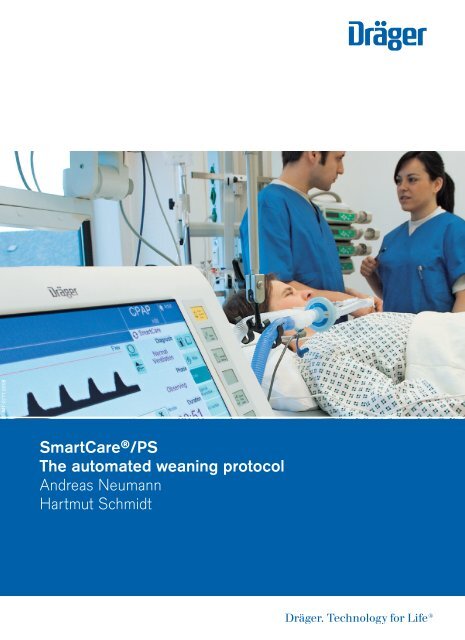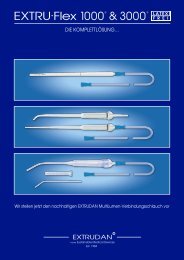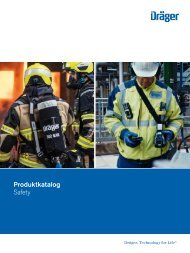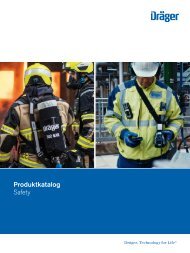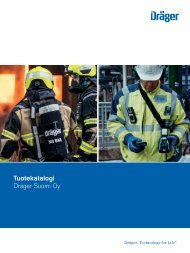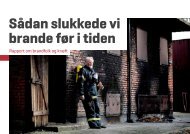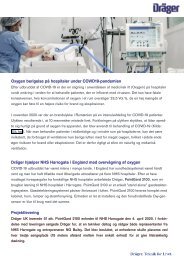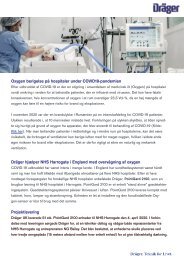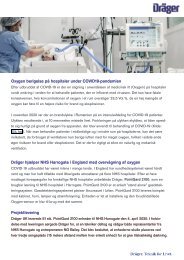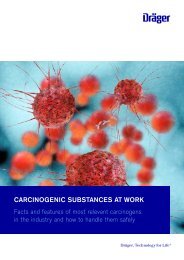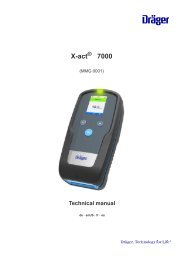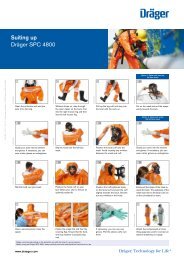SmartCare®/PS - The Automated Weaning Protocol
SmartCare/PS is an automated weaning system that controls the ventilator in order to stabilize a patient’s spontaneous breathing in a “comfortable zone” and to reduce inspiratory support until the patient can be extubated. The system is based on clinical knowledge to classify the ventilator situation into specific diagnoses and to apply therapeutic measures appropriate to the specific diagnosis. These therapeutic measures are based on a clinical protocol that has been tested and verified during several years of development. The purpose of this booklet is to give inside information into the protocol, whereas the operating instructions describe the safe usage of SmartCare/PS.
SmartCare/PS is an automated weaning system that controls the ventilator in order to stabilize a patient’s spontaneous breathing in a “comfortable zone” and to reduce inspiratory support until the patient can be extubated. The system is based on clinical knowledge to classify the ventilator situation into specific diagnoses and to apply therapeutic measures appropriate to the specific diagnosis. These therapeutic measures are based on a clinical protocol that has been tested and verified during several years of development. The purpose of this booklet is to give inside information into the protocol, whereas the operating instructions describe the safe usage of SmartCare/PS.
Create successful ePaper yourself
Turn your PDF publications into a flip-book with our unique Google optimized e-Paper software.
MT-0771-2008<br />
<strong>SmartCare®</strong>/<strong>PS</strong><br />
<strong>The</strong> automated weaning protocol<br />
Andreas Neumann<br />
Hartmut Schmidt<br />
Lorem Ipsum dolor nommuny<br />
Henderit veliat lorem magna
SmartCare ® /<strong>PS</strong><br />
<strong>The</strong> automated weaning protocol<br />
Andreas Neumann<br />
Hartmut Schmidt
04<br />
Important note<br />
Medical knowledge is subject to constant change due to research and<br />
clinical experience. <strong>The</strong> author of this booklet has taken great care<br />
to make certain that the views, opinions and assertions included,<br />
particularly those concerning applications and effects, correspond<br />
with the current state of knowledge. However, this does not absolve<br />
readers from their obligation to take clinical measures on their own<br />
responsibility.<br />
All rights to this booklet are reserved by Dräger Medical AG & Co. KG,<br />
in particular the right of reproduction and distribution. No part of<br />
this booklet may be reproduced or stored in any form either by<br />
mechanical, electronic or photographic means without the express<br />
permit of Dräger Medical AG & Co. KG, Germany.
06<br />
Table of Contents<br />
Foreword 8<br />
Introduction 12<br />
SmartCare ® /<strong>PS</strong> in a nutshell 15<br />
SmartCare ® /<strong>PS</strong> in different weaning phases 16<br />
<strong>The</strong> phases of the weaning protocol 16<br />
How SmartCare ® /<strong>PS</strong> diagnoses the respiratory status 20<br />
Back-on-track to normal breathing 24<br />
<strong>The</strong> spontaneous breathing trial 28<br />
<strong>The</strong> maintain phase 30<br />
Indications and contraindications 32<br />
Postoperative patients 33<br />
Adult patients 33<br />
Pediatric patients 33<br />
Patient contraindications 34<br />
A typical course of a patient session 35<br />
Before starting the patient session 35<br />
During the patient session 35<br />
Monitoring the progress 37<br />
Frequently asked questions 39<br />
Is SmartCare ® /<strong>PS</strong> failsafe, because it alters the<br />
pressure on its own? 39<br />
What if my patient goes apneic? 39<br />
Can I use any humidifier? 40
Table of Contents<br />
07<br />
Can I use SmartCare ® /<strong>PS</strong> at night to continue<br />
to keeping the patient stable, but not to wean? 40<br />
What if SmartCare ® /<strong>PS</strong> recommends “Consider<br />
Separation”, but no decision maker is available? 41<br />
Is SmartCare ® /<strong>PS</strong> affected by the usage of<br />
nebulized drugs? 41<br />
What happens during bronchial suctioning? 41<br />
Can I use automatic tube compensation<br />
with SmartCare ® /<strong>PS</strong>? 41<br />
Appendix I: Detailed SmartCare ® /<strong>PS</strong> responses<br />
in specific ventilatory situations 42<br />
Normal Ventilation 42<br />
Hyperventilation 43<br />
Tachypnoea 43<br />
Severe Tachypnoea 43<br />
Insufficient Ventilation 44<br />
Hypoventilation 44<br />
Central Hypoventilation 44<br />
Unexplained Hyperventilation 44<br />
Appendix II: Case studies 45<br />
Case I 45<br />
Case II 50<br />
Appendix III: References 52<br />
Appendix IV: Glossary 54<br />
Unit for measuring pressures 55
08<br />
Foreword<br />
Mechanical ventilation is one of the most complex processes<br />
conducted in modern hospital intensive care units. Figure 1<br />
shows that there are at least 6 major decision points along the<br />
continuum from admission to discharge for a ventilated<br />
patient. Despite decades of research, there are still no<br />
evidence-based guidelines for decision making at each point.<br />
And each point represents a delay loop if the patient does not<br />
meet the criteria to pass that point. Each delay increases both<br />
the cost of care and the risk of adverse events such as<br />
ventilator induced lung injury or ventilator associated<br />
pneumonia, among many others.<br />
N<br />
admit<br />
ventilate?<br />
Y<br />
intubate?<br />
Y screen? Y wean? Y extubate? Y successful? Y discharge<br />
N<br />
N<br />
N<br />
N<br />
N<br />
NIV<br />
Fig. 1:<br />
Decision points<br />
for a patient<br />
requiring mechanical<br />
ventilation.<br />
Y = yes, N = no,<br />
NIV = noninvasive<br />
ventilation<br />
A closer examination of Figure 1 reveals even more hidden<br />
complexity and the fact that not all decision points are equally<br />
difficult to manage. For example, the decision to ventilate is a<br />
fairly straight forward process of evaluating the presence of<br />
respiratory distress using, for example, commonly accepted<br />
blood gas ranges and clinical signs of dyspnea. <strong>The</strong> decision<br />
to intubate is mainly a function of how well the patient can<br />
protect their airway. Perhaps the most critical decision<br />
making step is for the clinician to first suspect that the<br />
patient might be able to tolerate weaning and thus initiate a<br />
screening test. Delay at this point may be the greatest obstacle<br />
to expeditious weaning. (1) <strong>The</strong> decision of whether or not to<br />
screen for possible weaning is based on whether the patient<br />
can tolerate the screening test. For example, an unstable
Foreword<br />
09<br />
patient with high PEEP and FiO2 requirements would not be<br />
a candidate. <strong>The</strong> purpose of the screening test is to decide<br />
whether or not to wean by predicting whether the patient will<br />
tolerate reduction of ventilatory support during the weaning<br />
process. Perhaps the most reliable screening test for this<br />
decision is the rapid shallow breathing index. (2) But it is<br />
the next decision, whether to extubate, that contains the<br />
complexity.<br />
Implied within the extubation decision making loop are all<br />
the manipulations that go into the weaning process. Studies<br />
comparing different modes of ventilation for weaning have<br />
yielded conflicting results. Yet it is generally accepted that<br />
intermittent mandatory ventilation (SIMV) is inferior to daily<br />
T-piece trials or Pressure Support ventilation (<strong>PS</strong>V) in terms<br />
of decreasing the duration of ventilation. (3) <strong>The</strong> use of <strong>PS</strong>V<br />
is attractive because it allows the possibility of gradual<br />
withdrawal of support to the level of just the resistive load<br />
caused by the artificial airway and connecting tubing. Yet<br />
determining the appropriate minimum level of <strong>PS</strong>V can be<br />
complicated by the use of a tracheostomy tube vs an endo -<br />
tracheal tube, use of a heat and moisture exchanger vs a heated<br />
humidifier and activation of automatic tube compensation<br />
(the more accurate way to support resistive load).<br />
Assuming that the endpoint for support reduction can be<br />
established (i.e., the decision point of whether to extubate<br />
has been reached) the path to that point is fraught with<br />
complications. All along the way the patient’s condition in<br />
terms of both gas exchange and comfort must be assessed.<br />
(1) Tobin MJ, Jubran A. <strong>Weaning</strong> from mechanical ventilation. In: Tobin MJ. Principles & practice of<br />
mechanical ventilation. 2nd edition. New York: McGraw-Hill, 2006:1185-1220.<br />
(2) Yang KL, Tobin MJ. A prospective study of indexes predicting the outcome of trials of weaning<br />
from mechanical ventilation. N Engl J Med 1991;324:1445-1450.<br />
(3) Eskandar N, Apostolakos MJ. <strong>Weaning</strong> from mechanical ventilation. Crit Care Clin<br />
2007;23(2):263-274.
10 Foreword<br />
This process implies not only clear definitions of patient state<br />
(eg, hypo- or hyper-ventilation, tachypnea, normality, etc), but<br />
also vigilance in applying surveillance techniques. Any delay<br />
or failure to properly assess these conditions necessarily leads<br />
to prolonged mechanical ventilation and the attendant costs<br />
and risks. <strong>The</strong> weaning stage is thus the Achilles heel of<br />
ventilator management. Clinicians are challenged with<br />
issues related to information overload, lack of standardized<br />
terminology, and practice variability. (4)<br />
Even when adequately explicit protocols are available,<br />
adherence to them is uncertain for a variety of psychological<br />
and practical reasons. Indeed, paper-based versions of any<br />
but the simplest protocols cannot be made explicit enough<br />
for practical implementation. (5) Adequately explicit<br />
computerized protocols contain the greatest detail. When<br />
used as open-loop control systems (ie, decision support only),<br />
computerized protocols may lead to the upper limit of<br />
achievable uniformity of clinician decision making. (6) Unlike<br />
a human (or even a team of humans), a computer is vigilant<br />
24 hours a day, 7 days a week. One study has shown that a<br />
computerized weaning protocol made an average of 56 <strong>PS</strong>V<br />
adjustments per day compared to 1 per day by humans. As a<br />
result of the heightened vigilance, patients spent less time<br />
with a high airway occlusion pressure (suggesting excessive<br />
work of breathing). (7)<br />
(4) Chatburn RL, Deem S. Should <strong>Weaning</strong> <strong>Protocol</strong>s Be Used With All Patients Who Receive<br />
Mechanical Ventilation? Respir Care 2007;52(5):609–619<br />
(5) Morris AH. Rational use of computerized protocols in the intensive care unit. Crit Care<br />
2001;5(5):249–254.<br />
(6) Morris AH. <strong>The</strong> importance of protocol-directed patient management for research on lungprotective<br />
ventilation. In: Dreyfuss D, Saumon G, Hubmayr R, editors. Ventilator-induced lung<br />
injury. New York: Marcel-Dekker; 2006: 537–610.<br />
(7) Dojat M., Harf A., Touchard D., Lemaire F., and Brochard L. Clinical evaluation of a computercontrolled<br />
Pressure Support mode. Am J Respir Crit Care Med 2000; 161:1161-6.<br />
(8) Chatburn RL. Computer control of mechanical ventilation. Respir Care 2004;49(5):507-515.
Foreword<br />
11<br />
What might the future hold for continued improvement in<br />
automated management of ventilators? <strong>The</strong> real challenge<br />
in control of ventilation is defining and measuring the<br />
appropriate feedback signals. If we stop to consider all the<br />
variables a human operator assesses, the problem looks<br />
insurmountable. Not only does a human consider a wide<br />
range of individual physiologic variables, but there are the<br />
more abstract evaluations of such things as metabolic,<br />
cardiovascular and psychological states. Add to that the<br />
various environmental factors that may affect operator<br />
judgment and we get a truly complex control problem.<br />
Nevertheless, human ingenuity is undaunted by complexity.<br />
If recent advances in ventilator design are any indication, (8)<br />
we will most certainly see a continuing trend of building<br />
more intelligence into the machine which will require a high<br />
level of human skill in assessing the appropriate use of such<br />
technology. With the right application, these advances offer<br />
the chance to further improve therapeutic quality and<br />
efficiency.<br />
Robert L. Chatburn, BS, RRT-N<strong>PS</strong>, FAARC<br />
Clinical Research Manager<br />
Section of Respiratory <strong>The</strong>rapy<br />
Cleveland Clinic
12<br />
Introduction<br />
Once the decision has been made to treat a patient with<br />
artificial respiration, the usual strategy during the treatment<br />
phase is to minimize invasiveness and duration of mechanical<br />
ventilation to avoid lung damage and further complications<br />
[1]. Especially long term ventilated patients can get so much<br />
accustomed to the ventilator that weaning them off the<br />
ventilator is a major task. It has been reported, that up to<br />
42 % of ventilation time in hospital is used for weaning alone<br />
[10]. As every ventilated patient has to be weaned, weaning<br />
protocols seem to be a good target for automation.<br />
Prevent<br />
Stabilize<br />
Wean<br />
Recover<br />
Noninvasive<br />
Ventilation<br />
Invasive<br />
Ventilation<br />
Fig. 2:<br />
<strong>The</strong> therapy phases<br />
for a ventilated<br />
patient throughout<br />
the continuum<br />
from admission to<br />
discharge<br />
SmartCare/<strong>PS</strong> is an automated weaning system that controls<br />
the ventilator in order to stabilize a patient’s spontaneous<br />
breathing in a “comfortable zone” and to reduce inspiratory<br />
support until the patient can be extubated. <strong>The</strong> system is<br />
based on clinical knowledge to classify the ventilatory<br />
situation into specific diagnoses and to apply therapeutic<br />
measures appropriate to the specific diagnosis. <strong>The</strong>se<br />
therapeutic measures are based on a clinical protocol that<br />
has been tested and verified during several years of<br />
development.<br />
<strong>The</strong> purpose of this booklet is to give inside information into<br />
the protocol, whereas the operating instructions describe the<br />
safe usage of SmartCare/<strong>PS</strong>.
Introduction<br />
13<br />
<strong>The</strong>re are many parallels between SmartCare/<strong>PS</strong> and the<br />
automatic landing systems widely used in commercial aviation<br />
today. In the early days of aviation landing a plane was a<br />
challenge even when visibility was good and wind was absent.<br />
But bad weather conditions, such as fog, made landings<br />
extremely risky. This situation lead to the development of<br />
systems that monitor the flight track of a plane. Over the<br />
years, systems like the ILS (instrument landing system) gave<br />
increasingly precise information to the pilot regarding<br />
whether the plane was on the glide path or not. In addition,<br />
flying a plane became easier by means of computer assisted<br />
flight controls (fly-by-wire) that replaced the direct mechanical<br />
control of the rudders and flaps. <strong>The</strong> latest development in<br />
automated landing systems automatically follows the landing<br />
procedures specific to every air field. Today, landing a so<br />
called Cat IIIc aircraft during bad weather can safely be<br />
accomplished regardless of fog and turbulent winds.<br />
Artificial ventilation of intensive care patients followed a<br />
similar track. <strong>The</strong> mechanically and pneumatically controlled<br />
ventilators of the past have been replaced by computer<br />
controlled ventilators. A wide variety of modes assist for<br />
fine tuning the ventilator to the patient’s requirements.<br />
Furthermore, the expanded monitoring capabilities of<br />
modern ventilators give detailed information about the<br />
ventilatory situation. <strong>Protocol</strong>s on how to use modes and<br />
change settings based on diagnoses were developed, and have<br />
to be followed by manually adjustments of the ventilator<br />
settings. Now with SmartCare/<strong>PS</strong>, an automatic system exists<br />
that controls the ventilator mode settings - based on a clinical<br />
protocol - in order to automatically wean a patient.
14 Introduction<br />
Moreover, SmartCare/<strong>PS</strong> was specifically designed with autolanding<br />
systems in mind; where during automatic landing<br />
procedures, the pilot always stays in full control of the plane.<br />
Not only does the pilot decide when to switch on the autopilot,<br />
but also supervises the autoland approach with the ability to<br />
override the system at any time. At the so called “decision<br />
height” the pilot decides to land the plane or re-configure<br />
the aircraft to climb.<br />
With SmartCare/<strong>PS</strong>, when the caregiver declares the patient<br />
fit for weaning, SmartCare/<strong>PS</strong> is switched on, weans the<br />
patient down along a defined track and reacts upon changes<br />
in the patient’s condition to bring him back-on-track. After<br />
an automatic spontaneous breathing trial, SmartCare/<strong>PS</strong><br />
indicates the possibility to separate the patient from the<br />
ventilator and keeps maintaining the patient at ventilatory<br />
support, until the caregiver decides to “land” the patient.
15<br />
SmartCare ® /<strong>PS</strong> in a nutshell<br />
<strong>The</strong> SmartCare/<strong>PS</strong> system is an automated clinical protocol,<br />
designed to stabilize the patient's spontaneous breathing in a<br />
comfortable zone of normal ventilation and to automatically<br />
reduce the inspiratory support.<br />
SmartCare/<strong>PS</strong> can be used for weaning intubated or<br />
tracheotomised patients with a body weight above 15 kg.<br />
<strong>The</strong> patients should be ready for weaning, i.e.,<br />
haemodynamically stable with adequate oxygenation and<br />
spontaneous breathing.
16<br />
SmartCare ® /<strong>PS</strong> in different<br />
weaning phases<br />
<strong>The</strong> phases of the weaning protocol<br />
Towards the end of the acute treatment phase of a ventilated<br />
patient, the main strategy of setting the ventilator is usually<br />
changed to weaning the patient off the ventilator. Regardless<br />
of which weaning protocol is applied, the course of weaning<br />
always follows the pattern of reducing the ventilatory support<br />
to a point where the readiness of the patient for extubation<br />
can be tested. Subsequent to a successful test and when<br />
certain other criteria are met, the patient can be<br />
disconnected from the ventilator and extubated.<br />
Fig. 3:<br />
Change in severity<br />
of lung illness<br />
during the phase<br />
from intubation to<br />
extubation<br />
healthy<br />
illness of the lung<br />
intubation<br />
time on a ventilator<br />
patient improvement<br />
extubation<br />
sick<br />
treat<br />
wean<br />
recover<br />
While maintaining appropriate oxygenation, the work of<br />
breathing is gradually shifted from the ventilator to the<br />
patient, depending on the patient’s capabilities to breathe on<br />
his own.
SmartCare ® /<strong>PS</strong> in different weaning phases<br />
17<br />
One of the weaning approaches widely applied is the<br />
combination of CPAP and Pressure Support. While FiO2 and<br />
mean airway pressure control the oxygenation, the Pressure<br />
Support level is used to gradually shift more work from the<br />
ventilator to the patient during weaning.<br />
Fig. 4:<br />
Simplified example<br />
of a Pressure<br />
Support weaning<br />
approach<br />
<strong>The</strong> approach is simple, decrease ventilatory support by a<br />
small amount, wait a while and check whether the patient<br />
can cope with the increased workload [Fig. 4]. Decrease<br />
support further if the patient does, or reverse the changes if<br />
he/she does not. Once the support level has been reduced to a<br />
minimum pressure target, perform a spontaneous breathing<br />
trial and then disconnect and extubate the patient when<br />
appropriate.
18 SmartCare ® /<strong>PS</strong> in different weaning phases<br />
This approach could easily be automated, but reality is not<br />
that easy. Patients given back the freedom to control their<br />
breathing pattern often deviate from the track of weaning<br />
into hypo- or hyperventilation, show signs of tachypnea, or are<br />
simply not adequately ventilated. A clinical protocol has to<br />
ensure that the patient is under continuous surveillance and<br />
that appropriate therapeutic measures are applied to bring<br />
him back-on-track if these undesirable situations occur.<br />
This is exactly where SmartCare/<strong>PS</strong> starts off. <strong>The</strong> patient’s<br />
ventilatory status is classified into 8 different diagnoses, and<br />
defined measures are taken to bring the patient back into a<br />
range called “normal ventilation”, or the zone of respiratory<br />
comfort. This core protocol is active during all phases of a<br />
SmartCare/<strong>PS</strong> session. Moreover, in a phase called “Adapt”<br />
the level of ventilatory support is gradually decreased, while<br />
continuously checking if the patient can tolerate the new level<br />
or not. If he/she does, the support level is weaned down<br />
further, if not, it is increased back to a level appropriate to<br />
the patient. <strong>The</strong> best case will be a step wise reduction of<br />
Pressure Support in a direct way until the lowest level is<br />
reached.<br />
SmartCare/<strong>PS</strong> adapts the settings up to every 5 minutes. To<br />
achieve such a tight compliance with a protocol, a caregiver<br />
would have to stand continuously in front of the ventilator<br />
and change the settings manually. <strong>The</strong>refore, in reality, time<br />
intervals between manual changes are much longer time.
SmartCare ® /<strong>PS</strong> in different weaning phases<br />
19<br />
Initiate<br />
Adapt<br />
Observe<br />
Fastest path<br />
Fallback in case of persistent instabilities<br />
Automatic protocol<br />
User action<br />
Maintain<br />
When the patient is weaned to a support level low enough,<br />
a spontaneous breathing trial is performed automatically<br />
where the patient is being observed over a period of time at<br />
lowest support levels. We call this phase “Observe”.<br />
SmartCare/<strong>PS</strong> then indicates the readiness of the patient to<br />
separate him from the ventilator and continues to maintain<br />
the low ventilatory support until the caregiver decides to<br />
actually separate the patient from the ventilator. This phase is<br />
called “Maintain”. In that phase the patient will be observed<br />
and treated in the same way as before until the caregiver<br />
decides to actually separate the patient from the ventilator.<br />
No<br />
Extubate?<br />
Fig. 5:<br />
Adapt:<br />
Guiding the patient<br />
inside a comfortable<br />
zone of normal<br />
ventilation to a<br />
minimum level of<br />
pressure support<br />
Observe:<br />
Supervised<br />
spontaneous<br />
breathing trial<br />
at minimum<br />
level of Pressure<br />
Support<br />
Maintain:<br />
Keeping the patient<br />
under automatic<br />
control after he/she<br />
has been declared<br />
“ready for separation<br />
from mechanical<br />
ventilation”<br />
Of course, if the patient fails the spontaneous breathing trial<br />
or deteriorates again, the protocol will enter the “Adapt”<br />
phase again and adjust the ventilatory support as required.
20 SmartCare ® /<strong>PS</strong> in different weaning phases<br />
How SmartCare ® /<strong>PS</strong> diagnoses the respiratory status<br />
Of course, SmartCare’s back-on-track protocol requires a<br />
diagnosis of the patient’s respiratory status. This job is done<br />
periodically. Based on clinical knowledge stored in the<br />
knowledgebase of SmartCare ® /<strong>PS</strong>, the current situation is<br />
classified into one of 8 diagnoses. SmartCare ® /<strong>PS</strong> then can<br />
apply therapeutic measures laid down in the protocol to bring<br />
the patient back into the desired range of ventilation.<br />
Fig. 6:<br />
SmartCare ® /<strong>PS</strong><br />
tries to keep the<br />
patient within the<br />
normal ventilation<br />
zone,<br />
and brings him<br />
Back-on-Track if<br />
diagnosed otherwise<br />
Unexplained<br />
Hyperventilation<br />
Hyperventilation<br />
Normal<br />
Ventilation<br />
Insufficient<br />
Ventilation<br />
Hypoventilation<br />
Tachypnoea<br />
Severe<br />
Tachypnoea<br />
Central<br />
Hypoventilation<br />
<strong>The</strong> 3 central criteria are:<br />
• Spontaneous breathing frequency (fspn)<br />
• Spontaneous tidal volume (VT)<br />
• Endtidal CO2 (etCO2)
SmartCare ® /<strong>PS</strong> in different weaning phases<br />
21<br />
<strong>The</strong> classification also takes the medical history into account.<br />
For instance, in the presence of COPD, where the level of etCO2<br />
is chronically increased, another set of etCO2 limits is used.<br />
Or in case of neurological disorders, where breathing patterns<br />
may differ from the normal ones, another set of spontaneous<br />
breathing frequency limits is used. Moreover, body weight is a<br />
major determinator for ventilation requirements. Depending<br />
on the body weight, different limits will be used for the tidal<br />
volume related to pediatric, adult, and larger adult patients.<br />
Classification<br />
V T<br />
every 10 sec<br />
Normal Ventilation<br />
etCO 2<br />
every 10 sec<br />
Severe Tachypnoea<br />
Insufficient Ventilation<br />
f spn<br />
BW<br />
every 10 sec<br />
initial setup<br />
Diagnosis<br />
every 2/5 min<br />
Hypoventilation<br />
Central Hypoventilation<br />
COPD<br />
initial setup<br />
Hyperventilation<br />
Unexplained Hyperventilation<br />
Neurologic Disorder<br />
initial setup<br />
Tachypnoea<br />
So in reality, the complete classification is based on a<br />
6-dimensional model of clinical expertise.<br />
Fig. 7:<br />
<strong>The</strong> actual situation<br />
is classified every<br />
2 minutes into 8<br />
different diagnoses<br />
based on 6 input<br />
parameters. After a<br />
change in support<br />
pressure, the next<br />
classification will be<br />
done after 5 min
22 SmartCare ® /<strong>PS</strong> in different weaning phases<br />
“Normal Ventilation” for an adult patient with no significant<br />
physiological limitations would be classified based on the<br />
following parameters:<br />
fspn:<br />
VT:<br />
etCO2:<br />
15 - 30 / min<br />
> 300 ml<br />
< 55 mmHg<br />
Nevertheless, the system chooses different settings from the<br />
knowledge base based on the settings for body weight, COPD<br />
and neurological disorder.<br />
Figure 8 shows a simplified, 2 dimensional excerpt from the<br />
classifiers diagnostic logic for patients with a body weight<br />
> 35 kg. Based on etCO2 and the spontaneous breathing<br />
pattern, the breathing status is classified into one of the<br />
diagnoses. While ignoring the other 4 parameters for this<br />
example, a patient with an etCO2 of 57 mmHg and a breathing<br />
frequency of 12 bpm would be diagnosed as “Hypoventilation”<br />
by the classifier (blue dot).<br />
Whereas a patient with an etCO2 of 35 mmHg and a breathing<br />
frequency of 20 bpm would be classified as “Normal<br />
Ventilation” (green dot).
SmartCare ® /<strong>PS</strong> in different weaning phases<br />
23<br />
55 mmHg<br />
Severe Tachypnoea<br />
Tachypnoea<br />
Insufficient<br />
Ventilation<br />
Normal<br />
Ventilation<br />
Hypoventilation<br />
Hyperventilation<br />
Fig. 8:<br />
Simplified model of<br />
SmartCare ® /<strong>PS</strong>’s<br />
classification for<br />
patients >= 36 Kg<br />
of body weight<br />
20 mmHg<br />
Unexplained<br />
Hyperventilation<br />
35 bpm<br />
etCO 2<br />
Fig. 9:<br />
30 bpm<br />
15 bpm<br />
f spn<br />
A classification of ventilation will be done by SmartCare ® /<strong>PS</strong><br />
every 2 minutes if there was no change of the level of Pressure<br />
Support, and every 5 minutes after a change. <strong>The</strong> classification<br />
is based on averaged values of breathing frequency, tidal volume<br />
and etCO2 taken every 10 seconds and the set values for body<br />
weight and medical history.<br />
<strong>The</strong> current diagnosis is displayed on the Evita XL screen and<br />
trended in a special trend graph.<br />
Evita Infinity ® V500<br />
(top) and<br />
Evita XL (bottom)<br />
display of Status<br />
and Diagnosis
24 SmartCare ® /<strong>PS</strong> in different weaning phases<br />
Back-on-track to normal breathing<br />
SmartCare/<strong>PS</strong> applies different therapeutic measures to<br />
adjust the support pressure depending on the current<br />
diagnosis given by the classification.<br />
Table 1:<br />
Overview over<br />
SmartCare/<strong>PS</strong>’s<br />
different therapy<br />
therapeutic measures.<br />
See appendix I for<br />
more details<br />
As the overall target is to wean the patient, the diagnoses<br />
“Normal Ventilation” and “Hyperventilation” are considered<br />
normal situations for a patient during weaning, whereas all<br />
other diagnoses indicate a certain level of instability. <strong>The</strong><br />
general reaction upon instabilities is to increase ventilatory<br />
support and/or notify the caregiver to check the patient’s<br />
condition. In the two normal situations the support pressure<br />
is reduced further down, with the step width and timing of<br />
the decrease adapted to the ventilatory situation.<br />
Diagnosis fspn VT etCO2 <strong>PS</strong><br />
Hypoventilation fspn
SmartCare ® /<strong>PS</strong> in different weaning phases<br />
25<br />
Instabilities are situations in which the patient is not<br />
classified in “Normal Ventilation” or “Hyperventilation”.<br />
A special trend display shows the classified diagnosis over<br />
time to review the patient’s stability. Moreover, a colored bar<br />
graph indicates the strategy chosen by the protocol:<br />
orange<br />
green<br />
light green<br />
= Inspiratory support is maintained or increased.<br />
= <strong>The</strong> patient is gradually being weaned.<br />
= <strong>The</strong> patient is hyperventilated, inspiratory<br />
support is gradually being reduced.<br />
Fig. 10:<br />
Typical example of<br />
the Diagnosis and<br />
<strong>PS</strong>upp trend. <strong>The</strong><br />
diagnosis under the<br />
blue cursor line<br />
(Evita XL) or orange<br />
cursor line (Evita<br />
Infinity V500) is<br />
“Normal Ventilation”<br />
Figure 11 shows a recording of a patient weaned with<br />
SmartCare. Within 5 hours, SmartCare/<strong>PS</strong> had successfully<br />
weaned the Pressure Support down. <strong>The</strong> PEEP was changed<br />
manually to 5 cmH2O after notification from SmartCare/<strong>PS</strong> at<br />
the beginning of the observation phase.
26 SmartCare ® /<strong>PS</strong> in different weaning phases<br />
Fig. 11:<br />
A typical course of<br />
a SmartCare ® /<strong>PS</strong><br />
patient session for<br />
an easy to wean<br />
patient without<br />
instabilities<br />
cmH 2 O<br />
30<br />
25<br />
20<br />
15<br />
Pmax<br />
P_PEEP<br />
10<br />
5<br />
0<br />
16:33<br />
16:45<br />
16:57<br />
17:12<br />
17:24<br />
17:39<br />
17:56<br />
18:08<br />
18:23<br />
18:38<br />
18:53<br />
19:08<br />
19:23<br />
19:35<br />
19:51<br />
20:03<br />
20:15<br />
20:27<br />
20:39<br />
20:55<br />
21:07<br />
21:19<br />
21:31<br />
How does SmartCare ® /<strong>PS</strong> determine the proper support<br />
pressures to set?<br />
First of all, the weaning steps are lowering Pressure Support<br />
by 4 cmH2O or 2 cmH2O. Like in the analogy with the<br />
airplane, where during the landing phase the rate of descent<br />
is higher in high altitudes, and lower at low altitudes,<br />
SmartCare/<strong>PS</strong> drops Pressure Support by 4 cmH2O at high<br />
supporting pressures, and by 2 cmH2O at low supporting<br />
pressures. <strong>The</strong> actual distinction between high and low<br />
support pressures is made based upon the variables: type of<br />
humidification, automatic tube compensation used and type<br />
of intubation at the time the patient session was started.<br />
Using an artificial nose (heat-moisture-exchanger HME)<br />
instead of an active humidifier, tracheostomy or endotracheal<br />
intubation, or even using advanced ventilation modes like<br />
automatic tube compensation (ATC TM ), changes the<br />
inspiratory resistance. This in turn has an impact on how<br />
much inspiratory support needs to be added to overcome<br />
these resistances. Moreover, changes in dead space<br />
introduced by different humidification methods have to be<br />
compensated.
SmartCare ® /<strong>PS</strong> in different weaning phases<br />
27<br />
In “Normal Ventilation”, the supporting pressure is kept<br />
stable, or weaned gradually down. If “Hyperventilation” is<br />
classified, SmartCare/<strong>PS</strong> will reduce the Pressure Support by<br />
4cmH2O immediately. According to the knowledge base, a<br />
patient classified in “Hyperventilation” is receiving too much<br />
ventilatory support, i.e. Pressure Support, and subsequently<br />
responds with a low breathing rate.<br />
In “Unexplained Hyperventilation” and “Central Hypo -<br />
ventilation” SmartCare’s action is to leave the pressure stable<br />
and to notify the caregiver to examine the patient. In case of<br />
“Unexplained Hyperventilation” the patient could have another<br />
problem, such as pain. A patient diagnosed with “Central Hypo -<br />
ventilation” could have other underlying issues, like increased<br />
intra-cerebral pressure caused by intra-cerebral bleeding.<br />
Usually the paCO2 (reflected by the etCO2) is the strongest<br />
drive of breathing. If a high CO2 level does not increase<br />
breathing activity, an examination of the patient is required.<br />
In all other classifications, Pressure Support will be increased.<br />
<strong>The</strong> level of increase is different for every diagnosis. <strong>The</strong> step<br />
width for an increase of Pressure Support at “Insufficient<br />
Ventilation” and “Tachypnoea” depends on the current level<br />
of Pressure Support, whereas “Severe Tachypnoea” and<br />
“Hypoventilation” will cause Pressure Support to increase by<br />
4cmH2O.<br />
Once SmartCare/<strong>PS</strong> has weaned the patient down to a<br />
specific goal pressure (again depending on the above stated<br />
variables), SmartCare/<strong>PS</strong> considers the patient ready for a<br />
spontaneous breathing trial. <strong>The</strong>refore, according to the<br />
clinical protocol, SmartCare/<strong>PS</strong> switches from the “Adaption”<br />
phase into “Observation” phase.
28 SmartCare ® /<strong>PS</strong> in different weaning phases<br />
<strong>The</strong> spontaneous breathing trial<br />
<strong>The</strong> ensuing phase – Observe – is a “Supervised Spontaneous<br />
Breathing Trial (SBT)”. Within this phase SmartCare/<strong>PS</strong><br />
controls the patient in the same way as during the adaption<br />
phase, except that the support pressure is not weaned down<br />
further. <strong>The</strong> patient is now observed for a specific period of<br />
time to check his ability to breathe normally at the lowest<br />
level of Pressure Support. <strong>The</strong> duration of the observation<br />
phase is determined by the level of Pressure Support at the<br />
start of the SmartCare/<strong>PS</strong> session. Again, the variables for<br />
HME, ATC TM and intubation type are used to compensate for<br />
the inspiratory resistance and dead space. But as a rule of<br />
thumb: High levels of <strong>PS</strong>upp at the beginning of a<br />
SmartCare/<strong>PS</strong> session will result in an observation phase that<br />
lasts 2 hours, whereas low levels will result in a 1 hour period.<br />
<strong>The</strong> start of the observation phase requires a PEEP of<br />
5cmH2O or below which has to be set by the user. If the<br />
currently set PEEP is higher than 5 cmH2O the user will be<br />
notified.<br />
If during the spontaneous breathing trial the patient shows<br />
signs of instability, SmartCare/<strong>PS</strong> will react appropriately<br />
with the therapeutic measures described above.
SmartCare ® /<strong>PS</strong> in different weaning phases<br />
29<br />
Evita XL<br />
Evita Infinity ® V500<br />
<strong>The</strong> intended therapy course of this Clinical <strong>Weaning</strong> Guideline has been<br />
successfully applied, i.e. the therapy goal is met. Evaluate clinical condition of<br />
patient and consider separation of patient from mechanical ventilation.<br />
As long as instabilities do not exceed 20 % of the elapsed<br />
Observation-phase time they are accepted. For instance, if<br />
30 minutes of observation have elapsed, SmartCare/<strong>PS</strong> would<br />
tolerate instabilities up to 6 minutes. Should the entire time<br />
of instability be longer than the mentioned 20 %, the<br />
spontaneous breathing trial will be aborted, and the adaption<br />
phase will be entered again.<br />
If the patient passes the Observation phase successfully,<br />
SmartCare/<strong>PS</strong> will inform the user with: “Consider<br />
Separation” This is the start of the last phase – Maintain.
30 SmartCare ® /<strong>PS</strong> in different weaning phases<br />
<strong>The</strong> Maintain phase<br />
In the Maintain phase the patient will be observed and<br />
treated in the same way as before: SmartCare/<strong>PS</strong> will classify<br />
the patient every 2 minutes – because changes are not<br />
expected in the level of Pressure Support – until the clinician<br />
separates the patient from the ventilator, with a possible<br />
extubation following.<br />
Should the patient have passed the observation phase, the<br />
weaning was considered successful and the healthcare<br />
provider could consider an extubation. Nevertheless,<br />
especially in weaning of long-term ventilated patients, clinical<br />
practice does not support the extubation immediately after a<br />
successful spontaneous breathing trial. For those patients<br />
who probably will need ongoing ventilatory support, the<br />
SmartCare/<strong>PS</strong> protocol applies different therapeutic<br />
measures to keep the patient stable, even in the presence of<br />
instabilities, where Pressure Support will temporarily be<br />
increased.<br />
Figure 14 shows a pressure trace from a patient that was<br />
weaned successfully, along with traces for frequency, tidal<br />
volume and end tidal CO2. During a few periods of instability<br />
during the maintain phase, SmartCare/<strong>PS</strong> increased the <strong>PS</strong>upp<br />
temporarily, but continued weaning afterwards.<br />
If instabilities persist for extended periods or occur too<br />
frequently, this patient is probably not stable enough to be<br />
extubated. As a consequence, the message “Consider<br />
Separation” will be retracted and the patient will have to<br />
pass a further Adaptation and Observation phase. In essence,<br />
a new weaning process will be started.
SmartCare ® /<strong>PS</strong> in different weaning phases<br />
31<br />
mL<br />
700<br />
600<br />
500<br />
400<br />
300<br />
vt_e f_spn etCO 2<br />
bpm/mmHG<br />
45<br />
40<br />
35<br />
30<br />
25<br />
20<br />
Fig. 13 & 14:<br />
Traces of a patient<br />
weaned with<br />
SmartCare.<br />
SmartCare ® /<strong>PS</strong><br />
reacts with adapted<br />
support pressure on<br />
instabilities during<br />
the maintain phase<br />
200<br />
100<br />
17:39<br />
17:51<br />
18:03<br />
18:18<br />
18:33<br />
18:48<br />
19:03<br />
19:24<br />
19:39<br />
19:51<br />
20:03<br />
20:27<br />
20:42<br />
21:03<br />
21:15<br />
21:27<br />
21:51<br />
22:16<br />
15<br />
10<br />
5<br />
22:34<br />
22:46<br />
0<br />
0<br />
cmH 2 O<br />
18<br />
16<br />
14<br />
12<br />
10<br />
8<br />
6<br />
4<br />
2<br />
0<br />
Pmax<br />
P_PEEP<br />
17:39<br />
17:47<br />
17:55<br />
18:03<br />
18:14<br />
18:22<br />
18:33<br />
18:44<br />
18:52<br />
19:03<br />
19:20<br />
19:28<br />
19:39<br />
19:47<br />
19:55<br />
20:03<br />
20:23<br />
20:31<br />
20:42<br />
20:59<br />
21:07<br />
21:15<br />
21:23<br />
21:31<br />
22:06<br />
22:20<br />
22:34<br />
22:42<br />
<strong>The</strong> patient has to follow the entire guideline until the lowest<br />
level of Pressure Support is reached again. And, of course, the<br />
patient has to pass the spontaneous breathing trial during an<br />
Observation-phase to be declared “Consider Separation”<br />
again.
32<br />
Indications and contraindications<br />
<strong>The</strong> use of SmartCare/<strong>PS</strong> requires that certain conditions be<br />
met by the patient and by the clinical findings so that a<br />
haemodynamically stable patient who has been connected to<br />
a ventilator for a long time can be weaned successfully, and<br />
with few complications. <strong>The</strong> decision whether or not to use<br />
SmartCare/<strong>PS</strong> is the responsibility of the attending physician.<br />
As with all other weaning therapeutic measures, a patient has<br />
to be ready for weaning from the ventilator. In general, the<br />
patients should be haemodynamically stable with adequate<br />
oxygenation and spontaneous breathing. SmartCare/<strong>PS</strong> is<br />
designed for weaning patients between 15 kg and 200 kg of<br />
real body weight.<br />
• Patient must be ventilated invasively (intubated or<br />
tracheotomised) in CPAP/<strong>PS</strong><br />
• Patient must be haemodynamically stable<br />
• Patient must have an ensured drive of breathing; must be<br />
able to trigger a breath<br />
• Patient’s level of sedation must be low enough to enable<br />
spontaneous breathing<br />
• Patient must not have an exacerbated COPD<br />
• Patient must not have severe neurologic disorder that<br />
effects the cerebral control mechanism of the spontaneous<br />
breathing patter, i.e., respiration rates above 34 bpm.<br />
Moreover, the same criteria that are used for considering the<br />
start of the weaning process should be used, of course tailored<br />
to the individual patient [1]:<br />
• Patient should have sufficient oxygenation e.g.<br />
paO2 ≥ 60 mmHg at FiO2 = 0.4<br />
• Patient should not have a significant V/Q mismatch e.g.<br />
pulmonary embolism<br />
• Acid-Basis status should be balanced<br />
• Patient should not have fever<br />
For further preconditions, especially on the settings of the<br />
ventilator, please refer to the operating instructions of the<br />
device.
Indications and contraindications<br />
33<br />
Postoperative patients<br />
<strong>The</strong> clinical protocol of SmartCare/<strong>PS</strong> was designed for the<br />
weaning of long-term ventilated patients. Step width reduction<br />
of inspiratory support and waiting periods to see if the patient<br />
is capable to breathe at lower support levels, as well as the<br />
duration of the Observation Phase, are designed for those<br />
patients. <strong>The</strong>refore, short term ventilated postoperative<br />
patients could probably be weaned more rapidly with manual<br />
fast track protocols using advanced modes like MMV [1].<br />
Adult patients<br />
SmartCare/<strong>PS</strong> is suitable for adult patients from 35 kg to<br />
200 kg of body weight. Patients can be endotracheally<br />
intubated or tracheotomized. Active humidification or heat<br />
moisture exchangers (HME) can be used.<br />
Automatic tube compensation (ATC TM ) can be used and has to<br />
be set at 100 %. This is very suitable for the spontaneous<br />
breathing trials.<br />
Pediatric patients<br />
For pediatric patients with a body weight between 15 kg and<br />
35 kg, some special rules apply. SmartCare/<strong>PS</strong> can only be<br />
utilized for endotracheal intubated patients. Moreover, HMEs<br />
or other filters that increase the resistance shall not be used.<br />
Humidification has to be delivered by an active humidifier.<br />
Due to the airway leakages common in pediatric patients,<br />
leakage compensation has to be switched on, and ATC TM<br />
cannot be used.
34 Indications and contraindications<br />
Patient contraindications<br />
• Patients without spontaneous activity<br />
• Patients with respiratory instability<br />
• Patient real body weight below 15 kg or above 200 kg<br />
• Neonatal patients<br />
• Patients with significant shunting - V/Q mismatch<br />
• Patients who are pressure dependent -<br />
High PEEP > 20 cmH2O
35<br />
A typical course of a patient session<br />
We call the period during which SmartCare/<strong>PS</strong> is activated and<br />
adjusts the support pressure automatically a “Patient Session”.<br />
A typical sequence of a patient session would look like follows:<br />
Before starting the patient session<br />
1. <strong>The</strong> caregiver has checked that the patient is ready for<br />
weaning.<br />
2. Ventilation parameters and alarm limits are set in accord -<br />
ance with the patient's needs; ventilation mode is CPAP/<strong>PS</strong>.<br />
3. Parameters for body weight, intubation mode and<br />
humidification, as well as COPD and neurological disorders<br />
have been set.<br />
During the patient session<br />
1. SmartCare/<strong>PS</strong> is activated and first attempts to stabilize the<br />
patient's spontaneous breathing by adjusting the Pressure<br />
Support.<br />
2. Pressure Support is regularly adapted to the patient’s<br />
respiratory profile (characterized by the spontaneous<br />
breathing frequency, tidal volume and end-expiratory CO2<br />
concentration).<br />
3. On the basis of these values, ventilation is classified by<br />
SmartCare/<strong>PS</strong> every 2 or 5 minutes.<br />
4. When Pressure Support reaches a minimum value (defined<br />
through “Intubation” and “Humidification” and ATC TM<br />
on/off), SmartCare/<strong>PS</strong> starts a test equivalent to a<br />
spontaneous breathing trial (SBT).
36 A typical course of a patient session<br />
5. When this test is concluded successfully, the system displays<br />
a recommendation to disconnect the patient from Evita XL.<br />
6. <strong>The</strong> patient is maintained in normal ventilation until the<br />
caregiver decides to disconnect the patient.
37<br />
Monitoring the progress<br />
Since SmartCare/<strong>PS</strong> is an automated clinical protocol that<br />
runs on the Evita XL ventilator platform, all extended<br />
monitoring capabilities can be utilized to follow up the course<br />
of the patient session.<br />
Of particular interest during weaning are parameters that<br />
support the caregiver in the decision whether to keep the<br />
patient on a low level ventilatory support, or try an extubation<br />
after the spontaneous breathing trial was performed during<br />
the observation phase. Studies suggest that patients tolerant<br />
of SBT 30 – 120 minutes have approximately 77 % chance of<br />
successful extubation and an extubation failure rate (require<br />
reintubation of 4 – 23 %) [1]. So once completed, SmartCare’s<br />
1 or 2 hour observation phase already gives a good prediction<br />
of extubation success.<br />
Combined with appropriate monitored parameters, this<br />
probability could be increased further. <strong>Weaning</strong> indices like<br />
Rapid-Shallow-Breathing-Index (RSBi or fspn/VT-ratio) and P0.1<br />
are proven to be useful in this context, especially if they are<br />
trended [5].<br />
Beside other standard parameters the following are<br />
considered of particular value for predicting successful<br />
extubation [5, 8]:<br />
• P0.1<br />
< 3 to 6 cm H2O<br />
• RSBi < 105<br />
• Successful SBT (Spontaneous Breathing Trial)
38 Monitoring the progress<br />
“… few predictors are reliable, except the Rapid Shallow<br />
Breathing Index.<br />
Possibly … the clinician has already factored such (other)<br />
information during bedside evaluation” [5]<br />
Of course, not only is the SBT automatic, but RSBi and P0.1 are<br />
also available in the Evita XL trend display.<br />
Trends to consider:<br />
• Trends of SmartCare/<strong>PS</strong> values – SC_f_spn, SC_vt and<br />
SC_etCO2<br />
• fspn, VT, etCO2, Minute Ventilation<br />
• P0.1 (n = 3 - 6)<br />
• RSBi (n < 105)<br />
• CO2 Production (n = 200 mL/min)<br />
Moreover, for clinical studies or remote access, SmartCare/<strong>PS</strong><br />
offers the possibility to get online reports of the actual status<br />
through a built in web server.
39<br />
Frequently asked questions<br />
Is SmartCare ® /<strong>PS</strong> failsafe, because it alters the pressure on<br />
its own?<br />
SmartCare/<strong>PS</strong> is an independent add-on to Evita XL and does<br />
not alter the safety mechanisms built into the ventilator. All<br />
alarm limits reactions based on the severity of alarms remain<br />
untouched. <strong>The</strong>refore, it is we recommend setting the<br />
following alarm limits before starting a patient session:<br />
Parameter<br />
MV w<br />
MV W<br />
fspn W<br />
VTi W<br />
PAW W<br />
etCO2 w<br />
etCO2 W<br />
etCO2 W<br />
TApnea<br />
Alarmlimit<br />
– 25 % of current MV<br />
+25% of current MV<br />
40 breaths/min for patients with body weight > 35 kg<br />
60 breaths/min for patients with body weight ≤ 35 kg<br />
12 mL/kg BW<br />
42 cmH2O<br />
18 mmHg<br />
57 mmHg (without COPD)<br />
67 mmHg (with COPD)<br />
60 seconds<br />
What if my patient goes apneic?<br />
<strong>The</strong> Evita XL ventilator’s apnea ventilation will kick in as<br />
back-up ventilation in case of an apnea episode with the tidal<br />
volume and frequency you have set. In this case the caregiver<br />
is notified and the patient session is ended.
40 Frequently asked questions<br />
Can I use any humidifier?<br />
For patients with body weights > 35 kg, any active humidifier or<br />
passive heat-moisture-exchanger (HME) can be used.<br />
For patients with body weights below
Frequently asked questions<br />
41<br />
What if SmartCare ® /<strong>PS</strong> recommends “Consider<br />
Separation”, but no decision maker is available?<br />
SmartCare/<strong>PS</strong> will enter the „Maintain” phase and keep the<br />
patient ventilated on the lowest level of Pressure Support.<br />
Should the patient develop instabilities or require higher<br />
levels of support pressure SmartCare/<strong>PS</strong> will stabilize the<br />
patient according to the protocol. Should instabilities persist,<br />
SmartCare/<strong>PS</strong> will switch back to the “Adapt” phase.<br />
Is SmartCare ® /<strong>PS</strong> affected by the usage of nebulized<br />
drugs?<br />
As long as the etCO2 and flow sensors are not rendered<br />
inoperable by excessive amounts of nebulized drugs,<br />
SmartCare/<strong>PS</strong> is not affected at all.<br />
What happens during bronchial suctioning?<br />
Endotracheal suctioning can be performed as often as<br />
necessary without having to activate any special procedure.<br />
However, it is highly recommended that the suction function<br />
of Evita XL be used with pre- and post-oxygenation. This<br />
allows SmartCare/<strong>PS</strong> to detect reactions to suctioning, so that<br />
respiratory changes are not considered as instabilities with<br />
subsequent actions based on the protocol.<br />
Can I use automatic tube compensation with<br />
SmartCare ® /<strong>PS</strong>?<br />
ATC TM can be used with SmartCare/<strong>PS</strong> at a 100 %<br />
compensation setting for patients with body weights above<br />
> 35 kg. It has to be active before starting a patient session.
42<br />
Appendix I: Detailed SmartCare ® /<strong>PS</strong><br />
responses in specific ventilatory situations<br />
<strong>The</strong> graphs indicate, how Evita XL will display the situation<br />
within the diagnosis trend.<br />
orange = Inspiratory support is maintained or increased.<br />
green = <strong>The</strong> patient is gradually being weaned.<br />
light green = <strong>The</strong> patient is hyperventilated, inspiratory<br />
support is gradually being reduced<br />
Normal Ventilation<br />
All values are acceptable<br />
In the case of bodyweight ≥ 35 kg<br />
fspn between 15 bpm and 30 bpm if no neurological disorder<br />
is present<br />
fspn between 15 bpm and 34 bpm if neurological disorder<br />
is present<br />
Vt above 300 ml if body weight is above 55 kg<br />
Vt above 250 ml if body weight is between 35 – 55 kg<br />
etCO2 below 55 mmHg if COPD is not present<br />
etCO2 below 65 mmHg if COPD is present<br />
In the case of bodyweight between 15 – 35 kg<br />
fspn between 18/min and 40/min<br />
Vt above 6 ml / kgBW – e.g. Vt = 180 ml at 30 kgBW<br />
etCO2 below 55 mmHg<br />
<strong>The</strong>rapeutic measures<br />
Continue weaning, decrease depending on the current level<br />
of pressure.
Appendix I<br />
43<br />
Hyperventilation<br />
This is usually a sign that the patient is receiving too much<br />
support.<br />
Classified by<br />
Acceptable etCO2 and tidal volume but low frequency<br />
<strong>The</strong> patient receives too much support<br />
<strong>The</strong>rapeutic measures<br />
Reduce Pressure Support directly after classification<br />
Tachypnoea<br />
Classified by<br />
Acceptable etCO2 and tidal volume but high frequency<br />
<strong>The</strong>rapeutic measures<br />
Increase in Pressure Support after classification depending<br />
on the current level of Pressure Support<br />
Alarm !!! – “SC: Persistent Tachypnoea” if 3 successive<br />
classifications “Tachypnoea”<br />
Severe Tachypnoea<br />
Classified by<br />
Acceptable etCO2 and tidal volume but very high frequency<br />
<strong>The</strong>rapeutic measures<br />
Increase in Pressure Support after classification<br />
Alarm !!! – “SC: Persistent Tachypnoea” if 3 successive<br />
classifications “Severe Tachypnoea”
44 Appendix I<br />
Insufficient Ventilation<br />
Classified by<br />
Acceptable frequency but etCO2 is too high or tidal volume is<br />
too low<br />
<strong>The</strong>rapeutic measures<br />
Increase Pressure Support after classification depending on<br />
the current level of Pressure Support<br />
Hypoventilation<br />
Classified by<br />
Acceptable tidal volume but low frequency and high etCO2<br />
<strong>The</strong>rapeutic measures<br />
Increase Pressure Support after classification<br />
Central Hypoventilation<br />
Classified by<br />
Low tidal volume and low frequency and high etCO2<br />
<strong>The</strong>rapeutic measures<br />
No reaction in Pressure Support<br />
Alarm !!! – “SC: Central Hypoventilation”<br />
Unexplained Hyperventilation<br />
Classified by<br />
Acceptable tidal volume but high frequency and low etCO2<br />
<strong>The</strong>rapeutic measures<br />
No reaction in Pressure Support<br />
Alarm !!! – “SC: Unexplained Hyperventilation”
45<br />
Appendix II: Case studies<br />
Case I<br />
by Andreas Möhlendick, Skaraborg Hospital, Skövde,<br />
Sweden<br />
A 15-year-old girl with no prior illnesses was vacationing in<br />
Thailand. She developed stomach pain and vomiting and was<br />
initially treated successfully there. After her return to Sweden,<br />
however, the patient developed nausea, vomiting and diarrhea<br />
that persisted for two days, eventually bringing her to the<br />
emergency room of the hospital in Skövde. <strong>The</strong> result of the<br />
initial diagnosis indicated unstable blood pressure with<br />
concomitant respiratory insufficiency. Massive indications of<br />
sepsis required her transfer to the ICU.<br />
Due to worsening respiratory insufficiency, the patient<br />
required ventilation. After successful intubation, ventilation<br />
was optimized using a lung-protective ventilation strategy.<br />
Treatment included a PEEP of up to 20 cmH2O.<br />
<strong>The</strong> patient's overall condition improved over the next few<br />
days, allowing the invasiveness of the ventilation to be<br />
incrementally reduced. On the fifth day, a PEEP of 10 cmH2O<br />
and FiO2 0.35 was set using the SmartCare/<strong>PS</strong> option of the<br />
Evita XL. With spontaneous ventilation, the PEEP was further<br />
reduced to 5 cmH2O. After ten hours, SmartCare/<strong>PS</strong> finally<br />
recommended extubation. Since it was late in the evening,<br />
the patient was not extubated until the following morning.<br />
She was extremely weak and exhausted. To be on the safe<br />
side, ventilation was continued noninvasively with the Evita<br />
NIV option. This treatment was discontinued after five hours<br />
and replaced by intermittent CPAP therapy
46 Appendix II<br />
Discussion<br />
<strong>The</strong> very rapid and positive improvement is certainly due to<br />
the consistent and aggressive treatment of the sepsis. At the<br />
same time, a high PEEP combined with spontaneous<br />
breathing lead to rapid recruitment. As a result, the patient's<br />
respiratory situation improved quickly. Without the<br />
recommendation to extubate from SmartCare/<strong>PS</strong>, Andreas<br />
Möhlendick, senior consultant of the Anesthiology and<br />
Critical Care Department, reports he would not have risked<br />
extubating the patient so soon after respiratory failure; he<br />
would have waited another two to four days.<br />
<strong>The</strong> SmartCare/<strong>PS</strong> option was installed on the Skaraborg<br />
hospital’s Evita XL ventilators in summer 2005 and has since<br />
been used for all patients who need to be weaned after several<br />
days of ventilation. Although the hospital is very well staffed,<br />
with at least one nurse for each bed, SmartCare/<strong>PS</strong> can<br />
change the <strong>PS</strong>upp pressure setting considerably faster than<br />
doing it manually. This is true both for reducing <strong>PS</strong>upp support<br />
as well as increasing it if the patient shows signs of<br />
exhaustion.<br />
Fig. 15:<br />
Andreas Möhlendick<br />
“Since we started using<br />
SmartCare/<strong>PS</strong>, I have found<br />
that we used to set the <strong>PS</strong>upp<br />
support too high at the<br />
beginning of ventilation,”<br />
says Möhlendick.
Appendix II<br />
47<br />
Fig. 16 and 17:<br />
Both lungs indicate<br />
a confluent infiltrate,<br />
pointing to ARDS
48 Appendix II<br />
Fig. 18:<br />
Two weeks after the<br />
initial lung x-ray,<br />
things have returned<br />
to normal
Appendix II<br />
49<br />
[cmH 2 O] & bpm<br />
45<br />
40<br />
35<br />
30<br />
25<br />
20<br />
15<br />
10<br />
5<br />
0<br />
P Supp [cmH 2 O] f spn [bpm] etCO 2 [mmHG] PEEP [cmH 2 O] mmHG<br />
700<br />
600<br />
500<br />
400<br />
300<br />
200<br />
100<br />
0<br />
20:02<br />
20:09<br />
21:00<br />
21:31<br />
22:01<br />
22:34<br />
23:01<br />
23:49<br />
0:52<br />
1:51<br />
2:18<br />
3:00<br />
3:27<br />
4:01<br />
4:28<br />
5:07<br />
5:44<br />
6:21<br />
6:46<br />
7:19<br />
7:49<br />
Fig. 19:<br />
<strong>The</strong> history graph at<br />
the end of ventilation<br />
clearly indicates how<br />
quick and effective<br />
SmartCare ® /<strong>PS</strong> reacts<br />
to the patient’s varying<br />
support requirements.<br />
Initially the<br />
SmartCare ® /<strong>PS</strong><br />
increases the Psupp<br />
pressure quickly in<br />
response to the high<br />
respiration rate and then<br />
attempts to reduce<br />
ventilation support again.<br />
<strong>The</strong> graph shows the<br />
same response when the<br />
breathing frequency<br />
increases again.<br />
In this instance, the<br />
CO2 graph remains<br />
relatively flat
50 Appendix II<br />
Fig. 20:<br />
Phillip Thaut<br />
Case II<br />
by Phillip Thaut, RRT-N<strong>PS</strong>, RPFT, Utah Valley Regional<br />
Medical Center, Provo, Utah, USA<br />
A 83 year old female was treated for Probable Myocarditits<br />
with possible aspiration and severe esophagitis. Additionally<br />
she suffered from COPD with chronic CO2 retention.<br />
Total Invasive Mechanical Ventilation: 8 days<br />
After initial intubation and stabilization; cardiac<br />
catheterization demonstrated relatively clean coronary<br />
arteries with an ejection fraction of approx. 22 %, probably<br />
due to acute myocarditis.<br />
After stabilization of hemodynamics and improved ejection<br />
fraction with inatropic support, weaning mechanics were<br />
obtained and spontaneous CPAP-Pressure Support trials were<br />
initiated via written protocols.
Appendix II<br />
51<br />
Six days of mechanical ventilation with limited tolerance for<br />
spontaneous CPAP–Pressure Support trials; Unable to wean<br />
and/or sustain Pressure Support levels < 18 cmH2O without<br />
significant tachypnea or weaning trial failure; Overwhelming<br />
ventilatory fatigue required > 24 hours A/C mode for recovery;<br />
Concerns regarding the risks for ventilator dependency and<br />
continued weaning failures prompted placing the patient on<br />
the Dräger Evita XL equipped with SmartCare/<strong>PS</strong> technology.<br />
With SmartCare the patient was able to sustain extended<br />
spontaneous CPAP-Pressure Support trials with Pressure<br />
Support titrated from 18 to 10 cmH2O and was liberated from<br />
invasive mechanical ventilation in < 48 hours; the patient was<br />
supported with intermittent non-invasive mask ventilation<br />
until discharge.<br />
“<strong>The</strong> most significant realization comes from the fact that<br />
the weaning process is continuous, and does not necessarily<br />
rely on the constant presence of a practitioner at the bedside<br />
throughout the weaning session” says Thaut.
52<br />
Appendix III: References<br />
[1] MacIntyre NR and the writing committee and Task force<br />
of the American College of Chest Physicians. Evidence-<br />
Based Guidelines for weaning and discontinuing<br />
Ventilatory support. Chest 2001;120:375S-395S.<br />
[2] Cook D, Meade M, Guyatt G, et al. Evidence report on<br />
criteria for weaning from mechanical ventilation. Agency<br />
for Health Care Policy and Research 1999.<br />
[3] Esteban A, Frutos F, Tobin MJ, et al. A comparison of<br />
four methods of weaning patients from mechanical<br />
ventilation: <strong>The</strong> Spanish Lung Failure Collaborative<br />
Group. NEJM 1995;332:345-350.<br />
[4] Ely EW, Baker AM, Dunagan DP, et al. Effect on the<br />
duration of mechanical ventilation of identifying patients<br />
capable of breathing spontaneously. NEJM<br />
1996;335:1864-1869<br />
[5] Meade M, Guyatt G, Cook D, Griffith L, Sinuff GT, Kergl<br />
C, Macao J, Esteban A, Epsgtein S. Predicting success in<br />
weaning from mechanical ventilation. Chest<br />
2001;120(suppl 6):400S-24S.<br />
[6] Brochard L, Rauss A, Benito S, Conti G, Mancebo J,<br />
Frekiik N, Gasparetto A, Lemaire F. Comparison of three<br />
methods of gradual withdrawal from ventilatory support<br />
during weaning from mechanical ventilation. Am J<br />
Respir Crit Care Med 1994;150:896-903.<br />
[7] MacIntyre NR, Epstein SK, Hess DR, et al. <strong>The</strong> evidence<br />
based weaning project: a clinical practice guideline for<br />
weaning from mechanical ventilation. Paper presented<br />
at: Chest 2000. October 26,2000; San Francisco.
Appendix III<br />
53<br />
[8] Yang KL, Tobin MJ. A prospective study of indexes<br />
predicting the outcome of trials of weaning from<br />
mechanical ventilation. NEJM 1991;325:1442-4.<br />
[9] Lellouche F et al. A Multicenter Randomized Trial of<br />
Computer-driven <strong>Protocol</strong>ized <strong>Weaning</strong> from Mechanical<br />
Ventilation. Am J Respir Crit Care Med Vol 174. pp<br />
894–900, 2006<br />
[10] Esteban A, Alia I, Ibanez J, et al. Modes of mechanical<br />
ventilation and weaning: a national survey of Spanish<br />
hospitals; the Spanish Lung Failure Collaborative Group.<br />
Chest 1994; 106:1188-1193
54<br />
Appendix IV: Glossary<br />
ATC TM<br />
bpm<br />
BW<br />
Comfortable zone<br />
COPD<br />
CPAP / <strong>PS</strong><br />
Diagnosis<br />
Duration<br />
etCO2<br />
fspn<br />
HME/filter<br />
Automatic Tube Compensation<br />
Breaths per minute<br />
Body weight<br />
<strong>The</strong> zone of respiratory parameters defined by spontaneous<br />
breathing frequency, tidal volume and end-expiratory CO2<br />
concentration<br />
Chronic Obstructed Pulmonary Disease, chronic bronchitis<br />
Ventilation with continuous positive airway pressure<br />
(Continuous Positive Airway Pressure) and Pressure Support<br />
for individual breaths (Pressure Support)<br />
Classification of ventilation by SmartCare/<strong>PS</strong> into one of eight<br />
different diagnoses: severe tachypnea, tachypnea, central hypo -<br />
ventilation, unexplained hyperventilation, insufficient venti -<br />
lation, hypoventilation, normal ventilation, hyperventilation<br />
Duration of the patient session<br />
End-expiratory CO2 concentration<br />
Spontaneous breathing rate<br />
Heated Moisture Exchanger<br />
Interfering operation User operations undertaken on Evita XL which may lead to a<br />
conflict with SmartCare<br />
MV<br />
Minute Volume, the volume ventilated in one minute<br />
Patient session Time during which pressure assistance is adjusted<br />
automatically<br />
Patient session journal Record of the therapy session<br />
PAW<br />
Airway pressure<br />
PEEP<br />
Positive End Expiratory Pressure<br />
Phase<br />
<strong>Weaning</strong> phases (adjustment, observation, maintenance)<br />
<strong>PS</strong><br />
Pressure Support<br />
<strong>PS</strong>upp.<br />
Magnitude of the inspiratory pressure assistance during <strong>PS</strong><br />
<strong>PS</strong>upp. goal<br />
Minimum inspiratory pressure assistance specified for the<br />
given patient
Appendix IV<br />
55<br />
<strong>PS</strong>upp. start<br />
SBT<br />
SC-etCO2<br />
SC-fspn<br />
SC-<strong>PS</strong>upp.<br />
SC-VT<br />
TApnea<br />
<strong>The</strong>rapy rights<br />
User<br />
VTe<br />
VTi<br />
WAS<br />
<strong>Weaning</strong><br />
Inspiratory pressure assistance when starting a patient session<br />
Spontaneous breathing trial<br />
End-expiratory CO2 concentration established by SmartCare<br />
Spontaneous breathing rate established by SmartCare<br />
<strong>PS</strong>upp. is automatically set by SmartCare, but can be altered<br />
by the user at any time<br />
Tidal volume established by SmartCare<br />
Duration of an apnea<br />
Right of medical or nursing staff to specify or undertake<br />
treatment<br />
SmartCare/<strong>PS</strong> user treating a patient<br />
Expiratory tidal volume<br />
Inspiratory tidal volume<br />
Web-based Application Service<br />
Gradual reduction of ventilation support with the aim of<br />
eliminating the need for same<br />
Unit for measuring pressures<br />
<strong>The</strong> International System of Quantities (ISQ) as defined in ISO 31 and ISO 80000<br />
defines Pascal (Pa) as the standard unit for measuring pressures. Nevertheless,<br />
within the medical literature and in common practise other units are used for<br />
airway pressure and etCO2. Throughout this booklet we use “cmH2O” for any airway<br />
pressure and “mmHg” for etCO2. Evita XL can be configured regarding the units for<br />
airway pressure (settings and measurements displayed), temperature and the<br />
measured and displayed etCO2 value.<br />
Please find below conversions of the units appearing in the booklet.<br />
• 1 cmH2O = 0.980665 mbar (1 cmH2O ~ 1 mbar)<br />
• 1 mmHg = 0.13332237 kPa<br />
• etCO2 values used within the booklet converted from mmHg into kPa:<br />
20 mmHg = 2.66 kPa, 35 mmHg = 4.66 kPa, 55 mmHg = 7.33 kPa,<br />
57 mmHg = 7.60 kPa, 60 mmHg = 7.99 kPa, 65 mmHg = 8.66 kPa
HEADQUARTERS<br />
Drägerwerk AG & Co. KGaA<br />
Moislinger Allee 53–55<br />
23558 Lübeck, Germany<br />
www.draeger.com<br />
REGION EUROPE CENTRAL<br />
AND EUROPE NORTH<br />
Dräger Medical GmbH<br />
Moislinger Allee 53–55<br />
23558 Lübeck, Germany<br />
Tel +49 451 882 0<br />
Fax +49 451 882 2080<br />
info@draeger.com<br />
REGION EUROPE SOUTH<br />
Dräger Médical S.A.S.<br />
Parc de Haute Technologie d’Antony 2<br />
25, rue Georges Besse<br />
92182 Antony Cedex, France<br />
Tel +33 1 46 11 56 00<br />
Fax +33 1 40 96 97 20<br />
dlmfr-contact@draeger.com<br />
REGION MIDDLE EAST, AFRICA,<br />
CENTRAL AND SOUTH AMERICA<br />
Dräger Medical GmbH<br />
Branch Office Dubai<br />
Dubai Healthcare City<br />
P.O. Box 505108<br />
Dubai, United Arab Emirates<br />
Tel + 971 436 24 762<br />
Fax + 971 436 24 761<br />
contactuae@draeger.com<br />
REGION ASIA / PACIFIC<br />
Draeger Medical South East Asia Pte Ltd<br />
25 International Business Park<br />
#04-27/29 German Centre<br />
Singapore 609916, Singapore<br />
Tel +65 6572 4388<br />
Fax +65 6572 4399<br />
asia.pacific@draeger.com<br />
REGION NORTH AMERICA<br />
Draeger Medical, Inc.<br />
3135 Quarry Road<br />
Telford, PA 18969-1042, USA<br />
Tel +1 215 721 5400<br />
Toll-free +1 800 437 2437<br />
Fax +1 215 723 5935<br />
info.usa@draeger.com<br />
Manufacturer:<br />
Dräger Medical GmbH<br />
23542 Lübeck, Germany<br />
<strong>The</strong> quality management system at<br />
Dräger Medical GmbH is certified<br />
according to ISO 13485, ISO 9001<br />
and Annex II.3 of Directive<br />
93/42/EEC (Medical devices).<br />
90 51 398 | 09.10-1 | Marketing Communications | LSL | LE | Printed in Germany | Chlorine-free – environmentally compatible | Subject to modifications | © 2010 Drägerwerk AG & Co. KGaA


